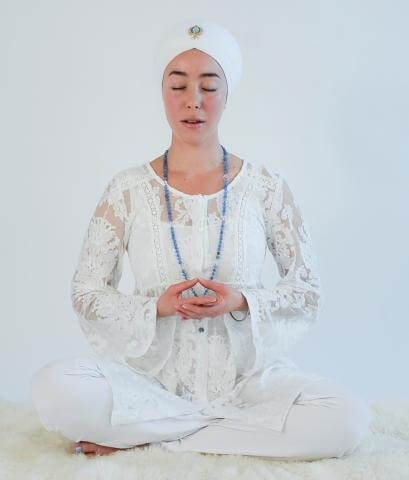“The practice of this meditation as soon as reasonably possible after a sudden shock can help as an immediate response and can be done several times throughout the night and early morning following the incident. This can serve to reduce the chance of post traumatic stress in the months ahead. It can also be beneficial to continue the meditation for 11 minutes once a day for 40 days, as indicated.”
-Dr. Shanti Shanti Kaur
The Practice
Posture: Sit in an Easy Pose, with a light jalandhar bandh (neck lock).
Eyes: Look at the tip of the nose, the Lotus Point.
Mudra: Relax the arms down with the elbows bent. Draw the forearms in toward each other until the hands meet in front of the body about 1 inch (2.5 cm) above the navel. Place the palms up, and rest the right hand in the palm of the left hand. Place the thumb tips together, and pull the thumbs toward the body.
Breath: Deeply inhale and completely exhale as you chant the mantra.
Mantra: Sat Nam Sat Nam Sat Nam Sat Nam Sat Nam Sat Nam Wahe Guru
Chant the mantra 3 times. The entire mantra must be chanted on only one breath. Use the tip of the tongue to pronounce each word exactly, and chant in a monotone. The rhythm must also be exact.

Begin with 11 minutes and slowly build up to 31 minutes.
Comments:
This meditation balances the left hemisphere of the brain with the base of the right hemisphere. This enables the brain to maintain its equilibrium under stress or the weight of a sudden shock.
It also keeps the nerves from being shattered under those circumstances. Under stress and sudden shock, the two hemispheres of the brain react differently. One side handles the more positive emotions and the other the more negative; one side deals with the unusual and threatening changes in the environment and the other analyzes and systematizes our responses.
This meditation uses the power of the mantra and the rhythm of the breath to create balance.
This meditation can be found in the KRI Level 2 Vitality and Stress Manual